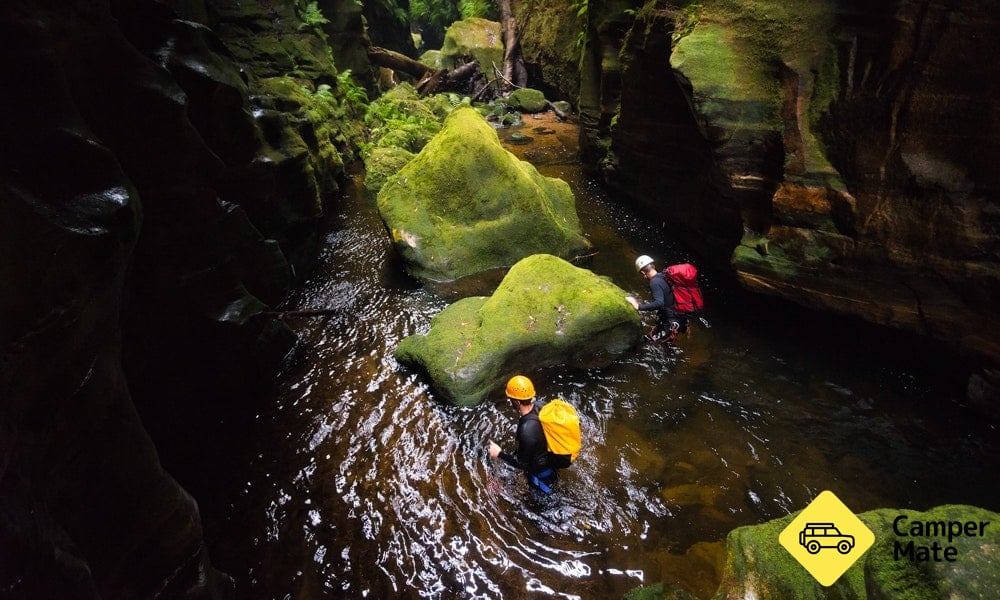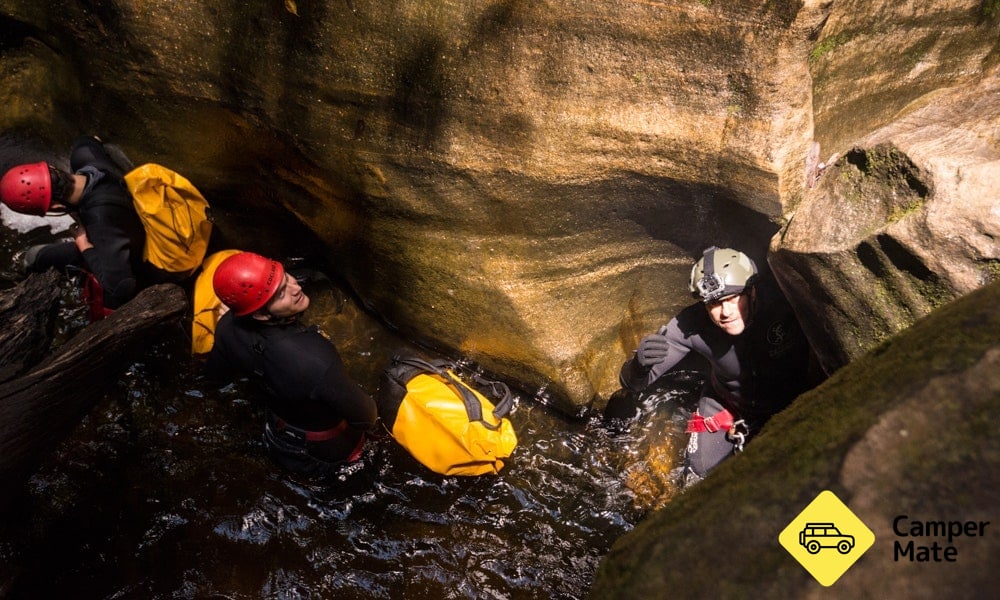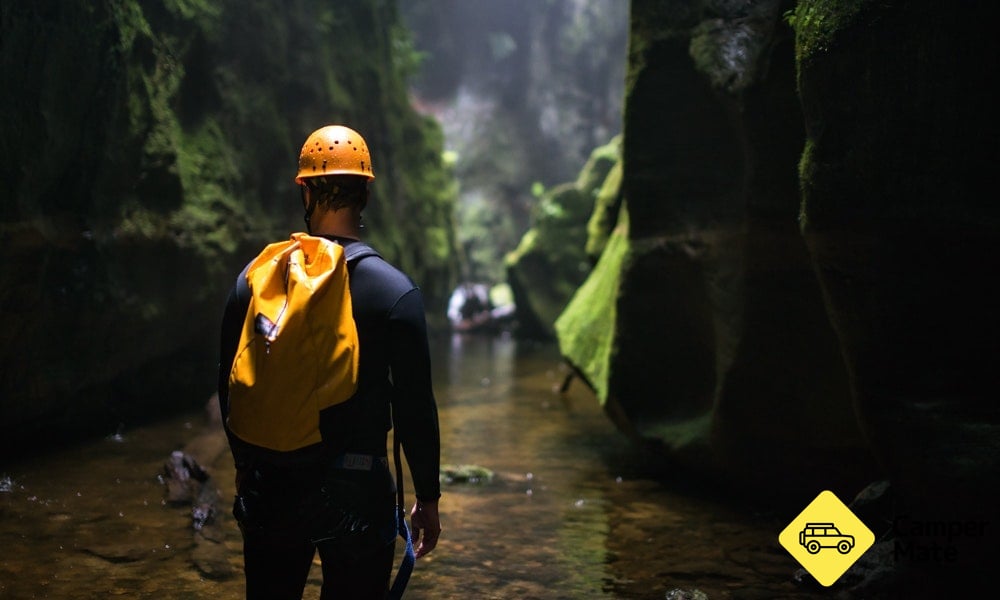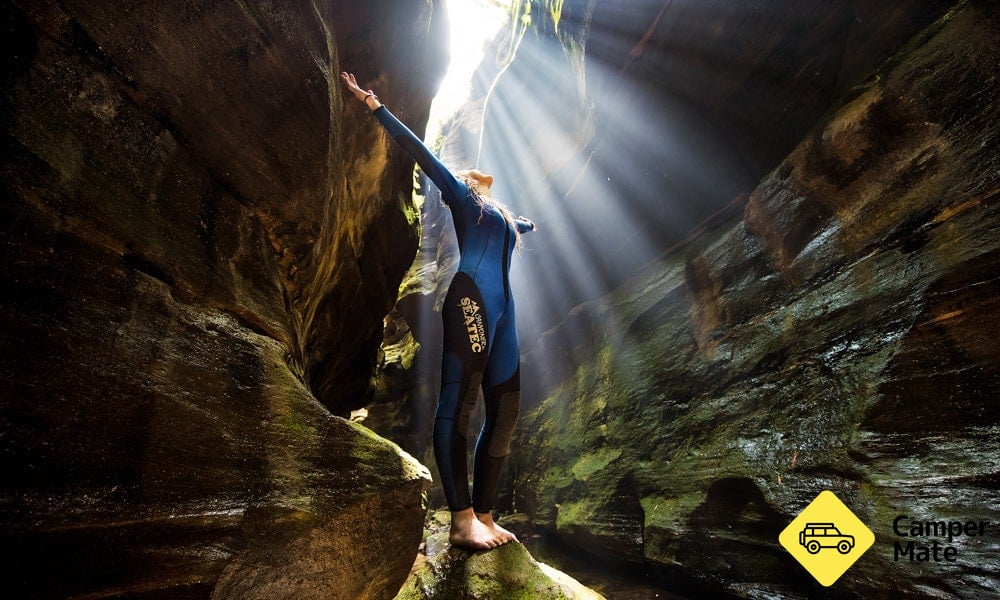
New South Wales
The Blue Mountains: a canyoner’s playground
February 28, 2018 • suzanne
6 min read
Have you ever seen canyoners in NSW’s Blue Mountains? You know, those wetsuit-clad crazies who scurry off the trail to follow in the footsteps of a frenzied creek? They slide, leap, scramble, swim, boulder and abseil to overcome obstacles, blending rock climbing and navigational skills to negotiate slippery slots and flooded ravines.
Canyoning can be physically challenging and at times, heart-in-mouth scary. So why do it? Because it’s the most fun you’ll ever have wearing a wettie that far from the ocean. And more to the point, the geology – which you won’t see from any old bush track mind you – is nothing short of stunning.
As the latest recruit at CamperMate HQ (and one whose outdoorsy-ness probably needed proving), I was sent off to the Blue Mountains to find out for sure: does canyoning live up to the hype?

Image credit: Jake Anderson
Gill Tutton from the Blue Mountains Adventure Company (BMAC) is guiding our party of six. He knows how to make damper from bush millet, is a certified snake wrangler, and can spot a crayfish in a creek at ten paces. He’s also regularly called on to rescue stranded climbers, so yep – we’re more than happy to put an Outdorian life in his hands.
He’s taking us deep into Wollemi National Park to Sheep Dip and Rocky Creek; two popular beginner canyons yoked together with a lush rainforest walk. We’re not abseiling today so algae, it seems, will be our likeliest hitch.
“Try to tread on the yellow parts of the rock” is the brief. And brief it is. Although there is a rhyme to help us remember. “Brown you’re down, green is mean, yellow you’re mellow.” In the poem our ankles trust!
And just like that we’re away, bashing through the bush in our helmets, harnesses and wetsuits before whooshing into the first of many dark, cold pools.
While it doesn’t have the drama of the region’s deeper gorges, Sheep Dip has face-first slides and water jumps for days, including one hair-raising six-metre plunge where more than a few F-bombs were dropped. (They say it’s optional, but is it really? When the alternative is looking like a wuss?) Like nature’s own water park, this is where the canyoning crowd goes for a jolly good time - and "Freezefest", we've heard, if you're bonkers enough to strip down in July.

Image credit: Jake Anderson
We're approaching the beginning of Rocky Creek – a notoriously cold constriction and one that we’ll later reverse – when Gill pokes a foot at the swollen water level and says off the cuff, “well, this’ll make it more exciting for you guys.”
He’s referring to a pothole known as the “washing machine”, and it’s looking particularly lively after 30mm of overnight rain. This, the way down, I think you’ll agree, has a name that warrants no further description.
Straddling the torrent, floundering for footholds, and grabbing onto anything within reach (including our guide’s upper thigh, sorry!), I can’t help but be reminded that pursuing a river’s deepest, narrowest reaches takes a fair amount of knowledge, and a little bit of guts.
Navigation and rope rigging expertise are the two skills any trip leader needs, so if you’re new to the sport, get yourself a guide. Even non-technical canyons can be testing; slick climbs and steep hikes are more difficult when you’re cold and carrying around 10kg of gear. Dexterity too can be compromised when your fingers are cold and stiff. Wetsuits with thermals underneath work magnificently to keep you warm and reduce the risk of hypothermia, but even so, wet canyoning trips won’t usually run beyond April.

Image credit: Jake Anderson
As with all adventures though, no risk goes unrewarded. And Gill has saved the best till last. After some deep, dark swims and a slide down a waterfall, we meander into what he considers “pristine canyon." Photographers, it should be noted, go to great lengths to shoot here, and we’re reminded to save our camera’s battery.
He’s right of course. Away from the rough-and-tumble waterfall action, adrenalin subsides and our trip takes a quiet, atmospheric turn. We wade and float down the twisting chasm, hemmed in by high, undulating walls dripping with mosses and ferns.
Sunlight does something here that begs the question – is this a canyon or a cathedral? And why can I suddenly hear Enya? Yeah, I could stay here awhile.
Water, I decide then and there, is nature’s finest sculptor, though not the most efficient. But creating any masterpiece takes time. Eroding the rock over millions of years, the tributaries of the Blue Mountains have slowly but surely carved out some of Australia’s most fascinating and unique geological features – and Rocky Creek is just one of many.
Covering almost 270,000 hectares of land, Sydney’s 50 million-year-old fortress of plateaus and valleys is home to hundreds of known canyons, and countless others that are yet to be or may never be, discovered. In terms of abundance and diversity of canyons, there’s nowhere else in Australia that comes close. No wonder expedition groups are regularly on the hunt for the next big discovery that they can slap a colourful name on and fly their (soaking wet) flag in. Rocky McRockface anyone?

Image credit: Jake Anderson
Canyoning is BMAC’s most popular activity, Gill says, in part because it ticks so many boxes.
“People want to get out to a remote part of the Blue Mountains away from the crowds, to see unique landscapes, and also get an adrenalin kick from the rope-based descents.”
“There’s a wide range of easy canyons that are only a few hours long, right up to colossal 18-hour days or multi-day trips where you’re carrying enough supplies for a week. If you can go up and down stairs comfortably and enjoy bush walking, there are canyons for you.”
The Grand Canyon Track and the more remote Wolgan View Canyon are at the easier end of the scale. Up a notch is the popular Empress Canyon which earned its fame thanks to a dramatic 30m waterfall abseil.
Missed the season? Dry canyons like Tigersnake (complete with an eerie 27m free-hanging rappel) mean you’re not necessarily restricted to exploring in the summer months. And if you’re experienced enough and up for the challenge, BMAC also organises invite-only trips; long, gruelling days where advanced abseiling skills and military-esque efficiency are prerequisites.
But wait, before you run off – what about us, standing here waist-deep in the Rocky Creek drink? Well, the simplest exit is to go out the way we came in. Which means it’s back into the washing machine for me.
We canyoned as guests of Blue Mountains Adventure Company (BMAC). BMAC specialises in abseiling, climbing, canyoning and hiking adventures in the Greater Blue Mountains World Heritage Area, and runs photography workshops in Rocky Creek with Jake Anderson.

